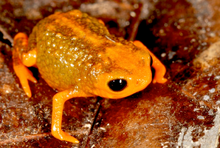| Brachycephalus boticario | |
|---|---|

| |
| Scientific classification | |
| Domain: | Eukaryota |
| Kingdom: | Animalia |
| Phylum: | Chordata |
| Class: | Amphibia |
| Order: | Anura |
| Family: | Brachycephalidae |
| Genus: | Brachycephalus |
| Species: | B. boticario |
| Binomial name | |
| Brachycephalus boticario Ribeiro et al., 2015 | |
Brachycephalus boticario is a species of frog in the family Brachycephalidae. It is very tiny and was one of seven new species described by LF Ribeiro and a team of scientists from the Mater Natura - Instituto de Estudos Ambientais in Brazil. Like all species in its genus, it is found in a very small strip of Atlantic Forest in the southeastern coast of the country, and has a vibrant colour pattern. The speciation seen in this genus is thought to be a byproduct of the rift between the valley versus mountain terrain and its particular microclimates, to which they are adapted. It might be in population decline due to habitat loss. The species name pays homage to the Fundação Grupo Boticário de Proteção à Natureza, which partially funded the fieldwork of the study originally describing the frog.
Description
This species is distinguished from its cogenerates by having a robust and bufoniform body, with an average adult length of between 10 and 12.7 millimetres (0.39 and 0.50 in); a rough dorsum; its overall light-brown colouration, turning a yellow colour on its ventral region of its legs, arms, the head's dorsum and as a stripe along its vertebral column. The skin on its dorsum shows no dermal co-ossification. Being a representative of the pernix group, its appearance is highly similar to B. pernix's, but is distinct from the latter by its rugose dorsum. Its rugose body dorsum is similar to that of B. verrucosus, as opposed to B. leopardus' smooth dorsum. Brachycephalus boticario lacks the dermal co-ossification proper of species in the ephippium group, and its shape and larger size distinguish it from species in the didactylus group, which are smaller on average and have a leptodactyliform body.
Distribution
Brachycephalus boticario is only known from its type locality, Morro do Cachorro, at a height of 795 metres (2,608 ft) above sea level, in the State of Santa Catarina.
References
- ^ Ribeiro, Luiz F.; Bornschein, Marcos R.; Belmonte-Lopes, Ricardo; Firkowski, Carina R.; Morato, Sergio A.A.; Pie, Marcio R. (2015). "Seven new microendemic species ofBrachycephalus(Anura: Brachycephalidae) from southern Brazil". PeerJ. 3: e1011. doi:10.7717/peerj.1011. ISSN 2167-8359. PMC 4458131. PMID 26056613.
- Webb, Jonathan (4 June 2015). "Seven tiny frog species found on seven mountains". BBC News. Retrieved 4 June 2015.
Further reading
- Clemente-Carvalho, Rute BG; et al. (2011). "Molecular phylogenetic relationships and phenotypic diversity in miniaturized toadlets, genus Brachycephalus (Amphibia: Anura: Brachycephalidae)". Molecular Phylogenetics and Evolution. 61 (1): 79–89. doi:10.1016/j.ympev.2011.05.017. hdl:11449/72702. PMID 21693192.
- Da Silva, Helio Ricardo; Campos, Leandro Ambrósio; Sebben, Antonio (2007). "The auditory region of Brachycephalus and its bearing on the monophyly of the genus (Anura: Brachycephalidae)". Zootaxa. 1422: 59–68. doi:10.11646/zootaxa.1422.1.4.
External links
| Taxon identifiers | |
|---|---|
| Brachycephalus boticario | |